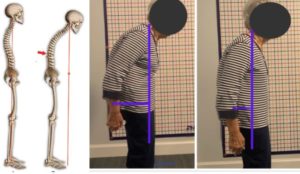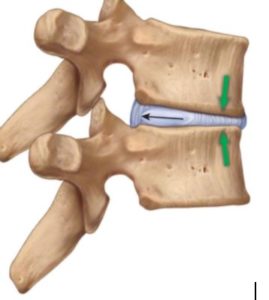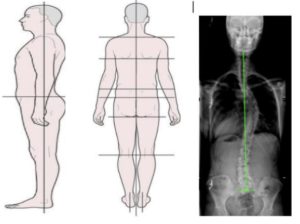Reduce Back Pain By Improving Your Posture
Is there a predictor for back pain in the future? The Scoliosis research is beginning to look at the correlation between 1) pain, 2) angle of the scoliosis curve 3) posture alignment measurements to determine why certain individuals have pain and others do not. If we can predict who will have pain, then we could possibly educate and try to correct these factors before the pain becomes an issue. Let’s take a look at a few of these pain indicators.
Looking at an individual in the sagittal plane (from the side) we can observe how upright their posture is. A forward trunk posture is found to be one of the predictors for pain.
By looking at the individual or at their x-ray, we can calculate the amount of forward trunk leaning by creating a line from the 7th cervical vertebrae to the ground (C7 plumb line).
We can then measure the distance between the line and the center of the pelvis. If this number is larger than 4cm it is considered a POSITIVE predictor of pain, meaning that this person is either currently in pain or will likely have pain in the future due to this forward trunk posture

Why would the forward trunk posture lead to pain?
From the pictures above, you can see that forward trunk posture stretches out the back muscles. The back muscles are overstretched, but still, need to work extra hard in an attempt to keep the person in an upright position. This puts the back muscles in an overworked, over the lengthened position. These muscles fatigue due to the extra work placed on them from the flexed posture, and fatigued muscles contribute to back pain.

Bulging Disks
Additionally, research shows that bulging disks are common with continued flexed trunk posture. The picture below shows 2 spinal vertebrae from the side. The green arrows represent the pressure on the front of the vertebra seen with trunk flexion. This pressure in the front causes the disk to push backward (black arrow) and begin to bulge in the back. We know from research that a standing flexed posture puts the most stress on the disks and increases the chance for a bulging disk.

In a groundbreaking study Nachemson, et al 1966, demonstrated how different postures have a huge impact on the pressure and hydration of the disk.
The research confirmed that the forward flexed posture (seen on the right side of the chart ) causes the most disk pressure and the most disk dehydration. The chart indicates that laying on your back with both knees bent is the best position for the disks in the back. The supine position has the lowest pressure on the disks and the most hydration of the disks. However, sitting or standing and leaning, as seen with forwarding trunk posture, has the most pressure on the back and is the most dehydration on the disk. As humans in an upright posture, we rely on the disks in our back to assist in a pain-free fluid motion, we need them to be as hydrated as possible without a great deal of pressure pushing them down. Once the disks are no longer flexible, they can bulge and contribute to back pain.
Forward Head Posture
The texting world is having an impact on head posture. The new texting posture with the head forward and down will significantly increase the amount of pressure on the disks in the neck. This increased weight and pressure can be explained by the figure below which displays how texting neck position is detrimental to our posture and a major contributing factor to back and neck pain.

How much does the scoliosis curve size correlate with pain?
Contrary to popular belief, studies have shown that there is no correlation between the degree of the curve and the amount of pain. In fact, research has shown that someone with a very large curve might have little to no pain. On the other hand, someone with a relatively small curve could have life-altering pain.
The research shows that postural alignment and a balanced posture is more important in predicting pain than the degree of the scoliosis curve.

Assessing posture in the frontal plane (side to side) one must look for symmetry between the right and left side of the body. When a line is drawn down the center of the body the right and left side of the line should be equal or balanced. This can be noted both on an x-ray and a visual evaluation of the person. When the body appears shifted in the frontal plane with a leaning towards the right or left side, it is an indication of pain in the future.
When assessing postural alignment we begin looking at the sagittal (sideways) view.
- Are the hips directly above the ankle?
- Are the hips directly above the ankle?
- Are the ears directly above the shoulders?
- Is there a lumbar lordosis (low back curve)?
- Is there a thoracic Kyphosis (upper back curve)?

In conclusion:
the size of the scoliosis curve is not a key indicator of back pain. Instead, a lack of balance in both the sagittal and frontal planes is the key indicator of back and neck pain. A physical therapist trained in posture specific scoliosis exercises can evaluate posture to determine where the postural imbalance is coming from. The physical therapist can design an individual exercise program to achieve an optimally balanced posture. The exercises will most likely include axial elongation, breath work, strengthening, and stretching. Back and neck pain is less likely to occur when an individual has a balanced and aligned posture.
To find out more about the Schroth Method and Scoliosi PTJax call (904) 372-3161 to schedule a free discovery visit. You can also visit them online at scoliosisPTJax.com